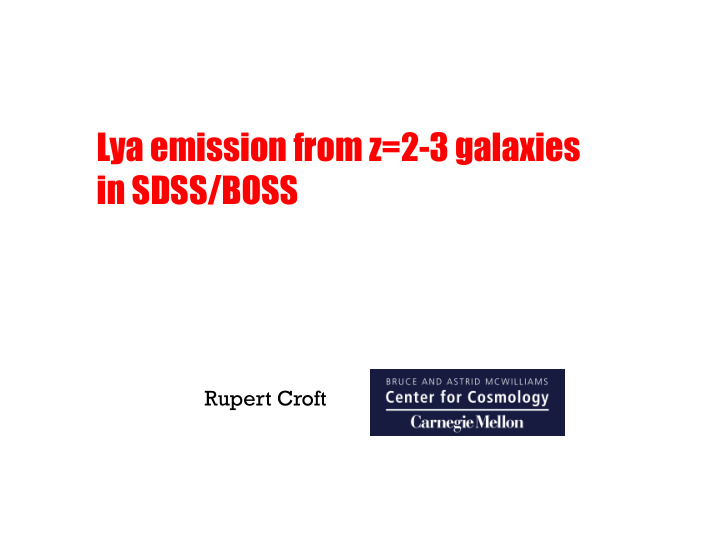



Lya emission from z=2-3 galaxies in SDSS/BOSS Rupert Croft
+ Other members of SDSS III/BOSS Ly α working group:
Talk plan: (1) Intro: Lya emission in the high-z universe -Lya emitting galaxies (“Lya emitters”) -Lya emission from IGM (2) How to use SDSS/BOSS spectra of z=0.5-1 galaxies to measure Lya emission from z=2-3 (DR9 has 530,000 galaxy spectra+ 55,000 QSO spectra) (3) Results and conclusions.
Traditionally, Lya emitters found using narrow band imaging, e.g., Yamada et al. 2012 (Subaru, z=3.1)
Blanc et al. 2011 (HETDEX pilot survey) Integral field unit (VIRUS) (line flux limit 5x10 -17 erg/s/cm -2 )
Hayes et al. 2010 (at z=2.2, f esc =5%) SFR from Ha SFR from Lya
Lya escape fraction declines at low-z : more dust
Fluorescent emission from IGM e.g., Gould & Weinberg 1996 Mean Lya surface brightness ~10 -22 erg/s/cm 2 /A/arcsec 2
Questions we would like answered: (1) What is mean Lya emissivity in the Universe, and how does it compare to integrating known Lya emitter LF? (2) ~5% of Lya emission from galaxies can be seen directly at z~2.5. How much is absorbed by dust, and how much just scatters into IGM and can be detected? (3) Can fluorescent emission from the IGM be detected?
History of ambitious observations… Published as Rauch et al. (2008)
BOSS spectrograph
Looking for Lya emission
Around QSOs the most photons are being pumped into the IGM. -look for Lya emission in fibers that pass close to QSOs sky fibers? pixel
Around QSOs the most photons are being pumped into the IGM. -look for Lya emission in fibers that pass close to QSOs Use galaxy pixel fibers with model galaxy subtracted Use 530,000 galaxy fibers
We expect 2 main contributions to Lya emission around QSOs: (1) Fluorescent emission from IGM- mainly reprocessed quasar radiation. (2) Emission from star forming galaxies clustered with QSOs.
Kollmeier et al. 2010
Kollmeier et al 2010
Predictions? (1) Galaxies around QSOs. Profile of Lya emission= mean SB (a) RH piece: quasar-lyae cross-clustering: From White et al. (2012) quasar bias=4 From Francke et al (2011) b lyae =1.8 -> b qso-lyae =sqrt(4 2 +2 2 )=2.8 -> r0 in power law cross-correlation function at z=2.5 = 3.9 Mpc/h (b) Second piece: integrate known Lye LF to (converges): Expect a mean SB of ~1.2x10 -21 erg/cm^2/s/A/arcsec^2
Predictions? (2) QSO induced fluorescent AGN emission. Very rough: For 1e44 erg/s luminosity in Lya line get equivalent emissivity epsilon_alpha at 4 Mpc/h ~ 5e39 erg/s/proper Mpc^3 -> ~10 -21 erg/cm^2/s/A/arcsec^2 similar mean SB to Lya emitters. (should use Lya RT sims around QSOs e.g., Kollmeier et al. for real prediction)
Potential contamination: light from other fibers CCD Spectrum 2 Spectrum 1
Signal vs difference between fiber numbers and r Quasar light itself is leaking into nearby galaxy spectra Solution: do not use quasar and galaxy spectra within 5 fibers
SDSS/BOSS ( Have subtracted background level computed using r=30-60 Mpc/h )
use 100 jackknife samples to compute covariance matrix and then do power law fit
SDSS3/BOSS 1,2,3 Rauch, sigma et al. 2008 92 hrs of VLT/FORS
SDSS3/BOSS Ha->Lya assuming no dust Known Lya emitting galaxies
Check: randomize galaxy fiber angular positions
Check: center on wavelength other than Lya
Low z half <z>=2.2
High z half <z>=3.1
Conclusions (1) What is mean Lya emissivity in the Universe, and how does it compare to integrating known Lya emitter LF? 3 sigma detection of mean Lya emissivity, value is 3x sum of known Lya emitters (2) ~5% of Lya emission from galaxies can be seen directly at z~2.5. How much is absorbed by dust, and how much just scatters into IGM and can be detected? The “true” escape fraction is between 5% and 20% (i.e. up to 15% scatters and can be detected) (3) Can fluorescent emission from the IGM be detected? Excess surface brightness over known lya galaxies is limited to be < 5e-21 erg/s/cm^2/arcsec^2 at 1 sigma (>10 times better than previous limits from 92hrs of VLT)
How many galaxies are expected to contribute to each bin?
Recommend
More recommend